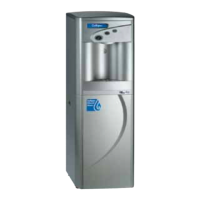
Do you have a question about the Culligan 12-WL2200-CUL and is the answer not in the manual?
Details about filter systems and appendix references for setup and configuration.
Details about RO systems and appendix references for setup and configuration.
Important installation, operation, and maintenance information along with hazard warnings.
Essential guidelines for safe electrical connections and handling of the unit's power supply.
Precautions for proper unit placement, water connection, and environmental conditions.
Description of the cold water tank, its capacity, temperature control, and UV protection.
Description of the hot water tank, its capacity, heating element, and safety thermostat.
Explanation of the room temperature water dispensing option and flushing advice.
Details on the UV lamp's function, specifications, and maintenance requirements.
Information about the Printed Circuit Board as the control unit and user interface indicator.
Details on the compressor type, refrigerant, and its temperature control mechanism.
Information on water connections, fitting approvals, and materials used in the water circuit.
Explanation of the solenoid valves used for water dispensing and their safety features.
Information on the materials used for the unit's exterior panels and their properties.
Diagram illustrating the internal layout of hot, cold, and ambient water components.
Steps for visually inspecting the unit for shipping damage and verifying components.
Procedure for preparing the unit, including filter head configuration and sanitizer cartridge setup.
Detailed steps for sanitizing the unit with a chlorine solution and flushing.
Steps for safely removing the sanitizing cartridge after the cleaning process.
Steps for installing and flushing new water treatment components, including RO systems.
Guidelines for selecting the optimal location and ensuring stable placement of the cooler.
Instructions for connecting the water supply, including pressure requirements and regulator recommendations.
Procedure for flushing and filling the unit's hot and cold tanks with water.
Steps to activate the heating and cooling systems and verify temperature settings.
Final checks for electrical safety, cleanliness, functionality, and customer satisfaction.
How to dispense cold water, including button operation and LED indicators.
Instructions for dispensing room temperature water using specific buttons and indicators.
Procedure for dispensing hot water, including button presses and indicator lights.
Steps to activate and dispense extra hot water, noting specific button sequences and LED changes.
Recommended schedule for replacing filters and UV lamps, and addressing potential calcium buildup.
Steps to prepare the unit, including disconnecting power, removing filters, and cleaning the quartz sleeve.
Detailed procedure for sanitizing the unit, including solution application and flushing.
Steps for safely removing the sanitizing cartridge after the cleaning process.
Instructions for installing new filters and reconnecting components after sanitization.
Final steps to flush the system, check for leaks, and return the unit to operational status.
Guidance on when descaling is necessary, particularly for units with RO configurations or hard water.
Identifies symptoms indicating the need to descale the hot water tank.
Steps to prepare the unit for descaling, including removing filters and using a sanitizing cartridge.
Procedure for applying and flushing a descaling solution to remove mineral buildup.
Final steps to flush the system after descaling, check connections, and return to service.
Addresses issues with no water flow, including supply, filter blockage, and valve problems.
Troubleshoots scenarios where only hot water flows, potentially due to cold tank freezing or mechanism issues.
Diagnoses problems with water temperature, checking thermostats and compressor functions.
Guides on checking power supply, unit setup, and internal fuses if the indicator is off.
Solutions for bad tasting water, including flushing and filter replacement.
Identifies causes for low cold water flow, possibly related to freezing or filter issues.
Addresses low water flow across all dispensing options, often due to filters or supply pressure.
Troubleshoots low flow specifically for hot water, possibly indicating scaling.
Diagnoses why hot water is not reaching the correct temperature, often electrical or overload related.
Addresses issues with the cold water not being sufficiently chilled, checking thermostat and ambient conditions.
Guides on troubleshooting UV lamp issues, checking connections, starter, and ballast.
Explanation of BioCote® as an anti-microbial solution and its benefits.
Addresses common questions regarding BioCote® application, lifespan, and effectiveness.
